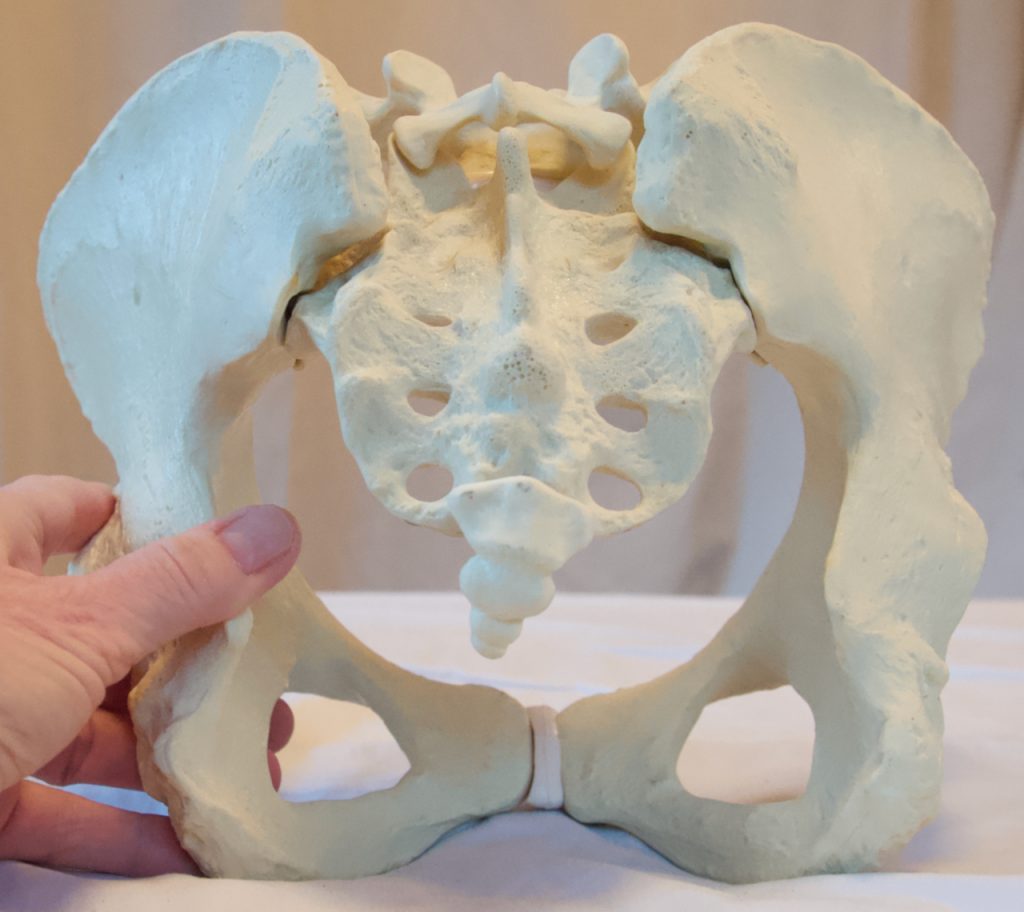How it All Starts
Pain in the posterior pelvis is common during pregnancy. It typically begins in mid pregnancy. Although, it can start at any time. Sometimes it goes away during pregnancy. If it does, that usually happens in the third trimester. Other times it persists long after the birth. Your mileage may vary.
Your SI Joints
This pain often comes from the sacroiliac (SI) joints. These are the joints between your sacrum (the triangular-shaped bone at the base of your spine) and the Ilia (the two pelvic bones on either side of the sacrum). These joints are supposed to be moveable.
I’m holding a female pelvis model in this photo. This is the back view. The sacrum is the triangular-ish bone with the six holes in it. The ilia are on either side. You can see the SI joints where they make contact.
SI Joints Are Supposed to Move
As pregnancy progresses, SI joint mobility increases. This is a good thing. It’s supposed to happen. Ultimately, more-mobile SI joints will allow your pelvis to subtly change size and shape to accommodate your baby in birth. This ensures smooth passage during the birth process. I say subtly, but sometimes I have seen surprisingly dramatic movement of the sacrum and movement of the ilia away from the sacrum as a baby descends in the birth process. The bones don’t really change size and shape, though. It’s the relationship between the bones that changes.
Your Ligaments
The structures that attach bones to bones are called ligaments. There are many strong ligaments that connect the SI joints. Ligaments are not stretchy or elastic. During pregnancy hormones and the weight of your growing uterus cause softening and slight lengthening of the ligaments. ALL of your ligaments and joints are affected and will become more mobile as throughout your pregnancy. This diminished stability is more noticeable in the pelvis because of the change in center of gravity in your pregnant body and increased pressure in your pelvis due to the weight of your growing baby. People have inherent differences in joint mobility. While not universally true, the people who are generally more flexible when not pregnant are more vulnerable to hyper-mobility during pregnancy. That makes sense, right?
Pelvic Instability
Pelvic instability during pregnancy is no joke. It can be quite painful. Sometimes the pain is in the back of the pelvis, the SI joints. That’s what I’m addressing in this article. Other times, it’s front and center where the pubic bones come together. I will address the front-and-center/pubic symphysis pain in another article.
As a bodyworker, I often see people who experience SI joint pain during pregnancy, I notice two main categories of causes. They both involve instability. One is a stuck SI joint. The increased mobility of pregnancy allows a joint to become distracted. That means the bones move away from each other. Then, when they come back together the alignment is off. Things get stuck and it hurts – on the stuck side. Sometimes this is called a subluxation. The other scenario I see is a long-standing stuck side that causes too much (chronic) mobility in the other side. Over time, the non-stuck side is essentially injured and becomes painful.
Get Professional Help
It’s really important to see a professional who can accurately assess and treat the problem. If you have the pain-in-the-struck-side version of this, the fix (or un-fix as I like to call it) is to get the thing unstuck. You need to see a DO, a DC a PT or skilled LMT who can mobilize bones and/or the soft tissue structures to allow the stuck joint to realign. This will provide almost instant relief if the pain is on the stuck side. If the pain is on a hyper-mobile side – any stuckness on the other side still needs to be addressed before stabilizing the hyper-mobile side(s).
Sometimes It Isn’t Stuck – Or At Least Not Stuck Anymore
Sometimes nothing is actually stuck. Or, you got the stuck side unstuck, but the never-was-stuck side is injured and painful. Instead, hyper-mobility is causing chronic injury/pain. In this case, stabilization is necessary. People with ongoing pain resulting from a hyper-mobility injury need stabilization. One key way to accomplish this is with a support garment. These are often called SI Belts or Trochanter belts. They are a tight fitting band that is worn around the pelvis to prevent excess movement in the pelvic joints while the ligaments heal. This is one example of this type of garment.
Here’s What You Can Do On Your Own
Yoga, right? Although, you need to pay particular attention to building strength to support your pelvis while not exacerbating the hyper-mobility.
The short video below by Shaina O’Neill-Butler will give you further information about ways to modify your yoga practice. It also includes practical things to do at home and out in the world to help you heal.
Until next time…
Namaste.
